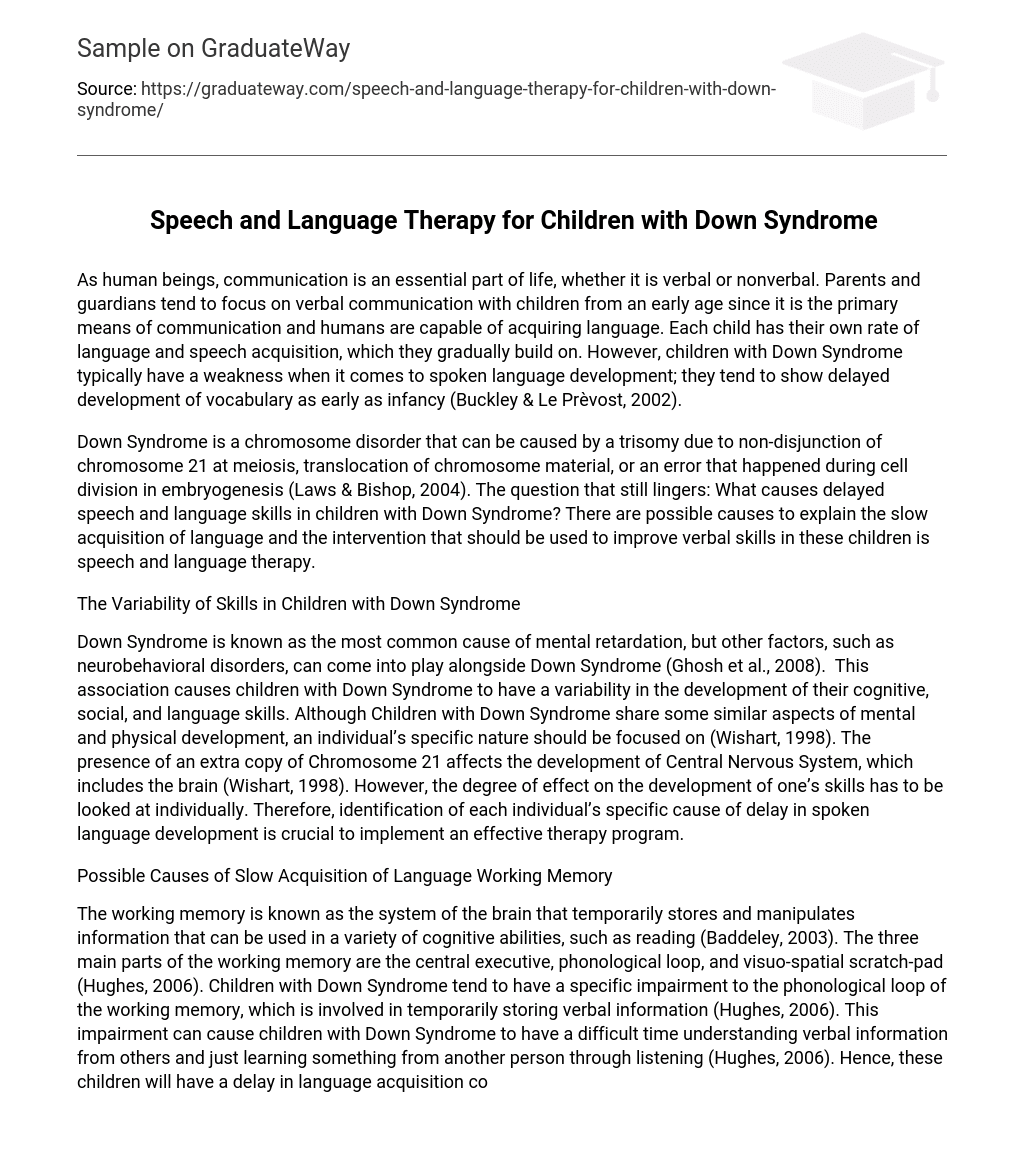As human beings, communication is an essential part of life, whether it is verbal or nonverbal. Parents and guardians tend to focus on verbal communication with children from an early age since it is the primary means of communication and humans are capable of acquiring language. Each child has their own rate of language and speech acquisition, which they gradually build on. However, children with Down Syndrome typically have a weakness when it comes to spoken language development; they tend to show delayed development of vocabulary as early as infancy (Buckley & Le Prèvost, 2002).
Down Syndrome is a chromosome disorder that can be caused by a trisomy due to non-disjunction of chromosome 21 at meiosis, translocation of chromosome material, or an error that happened during cell division in embryogenesis (Laws & Bishop, 2004). The question that still lingers: What causes delayed speech and language skills in children with Down Syndrome? There are possible causes to explain the slow acquisition of language and the intervention that should be used to improve verbal skills in these children is speech and language therapy.
The Variability of Skills in Children with Down Syndrome
Down Syndrome is known as the most common cause of mental retardation, but other factors, such as neurobehavioral disorders, can come into play alongside Down Syndrome (Ghosh et al., 2008). This association causes children with Down Syndrome to have a variability in the development of their cognitive, social, and language skills. Although Children with Down Syndrome share some similar aspects of mental and physical development, an individual’s specific nature should be focused on (Wishart, 1998). The presence of an extra copy of Chromosome 21 affects the development of Central Nervous System, which includes the brain (Wishart, 1998). However, the degree of effect on the development of one’s skills has to be looked at individually. Therefore, identification of each individual’s specific cause of delay in spoken language development is crucial to implement an effective therapy program.
Possible Causes of Slow Acquisition of Language Working Memory
The working memory is known as the system of the brain that temporarily stores and manipulates information that can be used in a variety of cognitive abilities, such as reading (Baddeley, 2003). The three main parts of the working memory are the central executive, phonological loop, and visuo-spatial scratch-pad (Hughes, 2006). Children with Down Syndrome tend to have a specific impairment to the phonological loop of the working memory, which is involved in temporarily storing verbal information (Hughes, 2006). This impairment can cause children with Down Syndrome to have a difficult time understanding verbal information from others and just learning something from another person through listening (Hughes, 2006). Hence, these children will have a delay in language acquisition compared to their peers. Hearing Loss Children with Down Syndrome usually have hearing problems since some characteristics of their ear structure differs from other children (Nightengale, 2018). Stoel-Gammon (2001) states that children with Down Syndrome typically suffer from mild-to-moderate conductive hearing loss.
In general, hearing loss from a young age causes a delay in the development of speech and language acquisition because communication from one person to another mainly involves hearing. Without being able to clearly hear what is being said to them, a child with down syndrome and hearing loss will not be able to develop their words as quickly as other children in the same environment.
Oral Motor Difficulties
The clarity of word and sound pronunciation are caused by oral motor skills and oral motor planning skills (Kumin 2006). Children with down syndrome typically have trouble voluntarily programming and organizing the sequence of movements of their mouth when speaking, which is a similar symptom in children with childhood verbal apraxia (Kumin 2006). A study was performed by Kumin and Adams (2000) on seven children with down syndrome that had difficulty with their speech. The characteristic of the speech of the children were examined using the published test, Apraxia Profile (Hickman, 1997).
The study showed that 100% of the children in the study showed characteristics of childhood verbal apraxia, with the main characteristic being longer uttering as the length of speaking increased (Kumin & Adams, 2000). Kumin (2006) also states that the difficulty children with down syndrome face with oral motor skills is due to weak facial muscles.
References
- Baddeley, A. (2003). Working memory and language: An overview. Journal of Communication Disorders,36(3), 189-208.
- Buckley, S, & Le Prèvost, P. (2002) Speech and language therapy for children with Down Syndrome. Down Syndrome News and Update, 2(2), 70-76.
- Ghosh, M., Shah, A. H., Dhir, K., & Merchant, K. F. (2008). Behavior in children with Down syndrome. The Indian Journal of Pediatrics, 75(7), 685-689.
- Hickman, L. (1997). The Apraxia Profile: The Descriptive Assessment Tool for Children. San Antonio, TX: Commu- nication Skill Builders.
- Hughes, J. (2006) Developing working memory skills for children with Down syndrome. Down Syndrome News and Update, 6(2), 57-61.
- Kumin, L. (2006). Speech intelligibility and childhood verbal apraxia in children with Down syndrome. Down Syndrome Research and Practice, 10(1), 10-22.
- Kumin, L. & Adams, J. (2000). Developmental apraxia of speech and intelligibility in children with Down syn- drome. Down Syndrome Quarterly, 5, 1-6.
- Laws, G., & Bishop, D. V. (2004). Verbal deficits in Downs syndrome and specific language impairment: A comparison. International Journal of Language & Communication Disorders, 39(4), 423-451.
- Nightengale, E. (2018). Hearing Loss in Children with Down Syndrome. The Hearing Journal, 71(2), 10.
- Stoel-Gammon, C. (2001) Down syndrome phonology: Developmental patterns and intervention strategies. Down Syndrome Research and Practice, 7(3), 93-100. doi:10.3104/reviews.118
- Wishart, J. G. (1998). Development in Children with Down Syndrome: Facts, findings, the future. International Journal of Disability, Development and Education, 45(3), 343-363.





